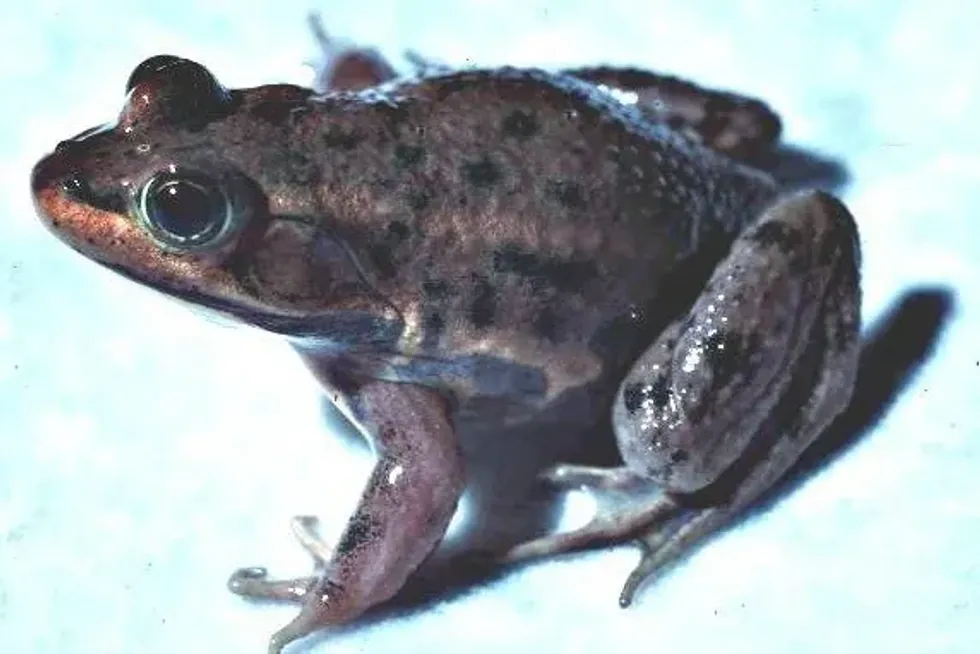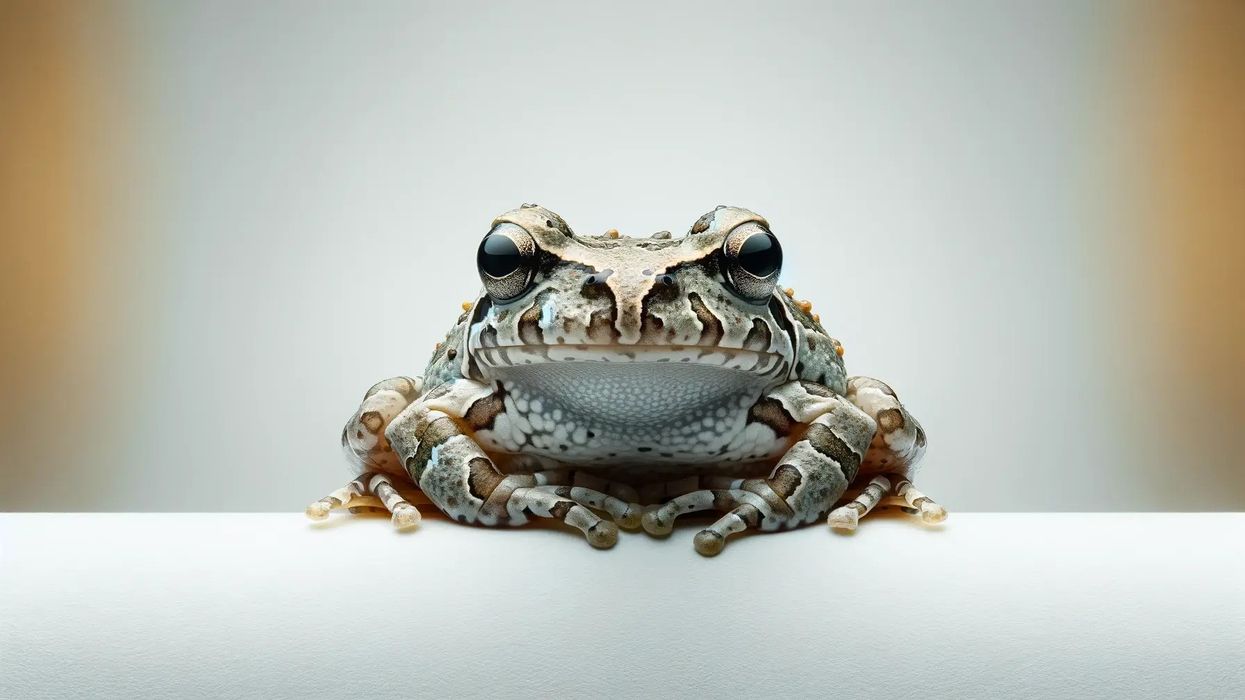Are you fascinated by amphibians, like pool frogs? Then here we have all the information about the carpenter frog. The carpenter frog, scientific name Lithobates virgatipes, is native to the Atlantic coastal plain of the continent of North America.
These frogs like to stay in rather acidic waters. The population of these frogs seems to be common still now, but they have been listed as a species of special concern in New Jersey. The breeding season of these frogs occurs around April-August and during this time, the female can lay around 200-600 eggs at a time.
These frogs have two distinctive features. The first is the web on their feet ends before reaching their longest toe.
The other is one distinguishing call of theirs. This specific call sounds like a carpenter hammering nails. This call is also the reason behind their name.
Read on to know more information about the carpenter frogs, like their geographical distribution. For more relatable content, check out these tree frog facts and African bullfrog facts for kids.
Carpenter Frog Interesting Facts
What type of animal is a carpenter frog?
Carpenter frog (Lithobates virgatipes) is a species of frog.
What class of animal does a carpenter frog belong to?
The carpenter frog belongs to the class Amphibia of the Animalia kingdom.
How many carpenter frogs are there in the world?
The exact population of the carpenter frogs in numbers is not known. However, the species is known to be common throughout most of its habitat range.
Where does a carpenter frog live?
Carpenter frogs are native to North America. They are known to live around the Atlantic coastal plain of the continent.
They can be found from the range of north Florida and Okefenokee Swamp of south Georgia to the range of Pine Barrens of New Jersey. They can be seen living in some inland parts as well, in South Carolina and southern parts of North Carolina.
What is a carpenter frog's habitat?
The primary habitat of the species is both still and moving water bodies where there's enough availability of aquatic vegetation and their surrounding wetlands.
They prefer to live in acidic water which looks muddy at the first glance as it helps these frogs camouflage. They can be seen in sphagnum bogs, gum swamps, flooded cranberry bogs, cypress dome, pine barren ponds, and artificial lakes.
They are heavily dependent on the water bodies to survive, so even when they are spotted out of the water, they are not far away from it.
Who do carpenter frogs live with?
Carpenter frogs are relatively solitary, and males of the species are known to be aggressive with other males while defending their territories. They can be seen in groups during the breeding season.
How long does a carpenter frog live?
The exact span of the life cycle of carpenter frogs living in the wild is not known, but the highest lifespan of a carpenter frog living in captivity has been recorded at 6.2 years.
How do they reproduce?
The carpenter frog breeding season occurs around April-August. These frogs reach sexual maturity at the age of one year old, and the adult frogs are known to be polygynandrous.
Upon the arrival of the breeding season, males of the species choose a place where the females can lay eggs. This place is basically in some still water where shrubs are submerged, and where there is plenty of aquatic vegetation.
Males then call out to get the attention of females, and they have been seen to become defendant towards their territories. The male will even compete aggressively with other males to protect its territory and to catch the attention of the female.
When the female chooses a partner to mate, they can be seen approaching the male. Larger males have more chances at the success of mating than smaller males.
After mating, females of the species lay egg masses that are round in shape. The egg masses contain about 200-600 eggs, and it stays attached to the submerged shrubs.
The carpenter frog eggs hatch after about one week, and not much is known about the parental care done by these frogs. Not much is known about the carpenter frog tadpole life cycle as well.
What is their conservation status?
The conversation status of the carpenter frogs according to the International Union for Conservation of Nature is listed as Least Concern. Along with having a wide habitat range, these frogs are common in that habitat range as well.
Many of these frogs are known to live within protected areas, but other than that, due to lack of research, not much conservation efforts have been taken for the animal.
Carpenter Frog Fun Facts
What do carpenter frogs look like?
Carpenter frog (Lithobates virgatipes) is a medium-sized frog species. They have an overall appearance of brown-colored frogs, that is, the limbs, head, and body of these frogs are brown.
Four golden or yellowish stripes can be seen running down their side and back above the brown back. Two of these stripes are more close to the lateral lines of the body of the frog, and the other two are closer to the central line of the body.
The ventral side of these frogs are yellow to cream-colored and have dark-colored mottled patterns.
A fading line can also be seen around the upper lip of these frogs. The most distinguishing feature of these frogs is that the web on their feet ends before reaching their longest toe.
How cute are they?
Carpenter frogs might not be considered cute by many people, but people who appreciate reptiles and amphibians might find this species interesting. The species is also not aggressive towards humans.
How do they communicate?
Carpenter frogs communicate visually and vocally. During the breeding season, males fight with each other, and at this time, they also give out a certain call to attract the female.
They also have several other calls which include an aggressive call towards their competitor, with whom they have locked into a fight. One is a chirping call, made by the female during courtship.
Another is a release call, made by a male when they have accidentally locked in with another male. The most distinctive carpenter frog call which gave these frogs their common name is 'pu-tunk, pu-tunk'.
The male carpenter frogs are capable of repeating this call up to 10 times at a time. This particular carpenter frog sound has been described as a carpenter hammering nails, and that's how they got their common name.
How big is a carpenter frog?
A carpenter frog is about 1.6-2.6 in (4.1-6.6 cm) in length. These frogs are two times smaller than common frogs. Common frogs are about 3-5 in (7.6-12.7 cm) in length.
How fast can a carpenter frog move?
The speed at which a carpenter frog moves is not known. However, frogs, in general, are known to be able to jump at a great distance.
How much does a carpenter frog weigh?
The exact weight of the species is not known. These are medium-sized frogs, so we can assume that they would not weigh a lot.
What are the male and female names of the species?
Males and females of the species have no specific names.
What would you call a baby carpenter frog?
The baby of a carpenter frog is known as a larva or tadpole.
What do they eat?
The diet of carpenter frogs is carnivorous. Their diet consists of small insects and small invertebrates, such as crayfish, mollusks, or spiders. They search for prey on both, land and in submerged vegetation.
How far can they jump?
How long carpenter frogs are able to jump is not known. However, some species of frogs can jump at a distance that is about 40 times their body length. The ability to jump this far at one leap helps frogs escape from predators. Goliath frogs are known to be the fastest frogs in the world.
Would they make a good pet?
They are not the first choice as pets for the people who keep frogs as pets, but carpenter frogs are known to do well and adapt easily in captivity. They are also not poisonous unlike many poison frogs living in this world. However, they are a shy species and tend to keep away from the human population.
Did you know...
Carpenter frogs look similar to bullfrogs, especially to the species of American bullfrogs. American bullfrogs lack the golden or yellowish stripes of the carpenter frog, but otherwise, they have almost the same appearance.
Why is the carpenter frog going extinct?
The carpenter frog is not a threatened species across its habitat range according to the International Union for Conservation of Nature. The carpenter frog conservation status is rather Least Concern.
However, for the population of the carpenter frog, habitat destruction has become a huge issue. In New Jersey, they have been declared as a threatened species in their habitat range and have been listed as a species of special concern.
How to take care of a carpenter frog?
If you want to keep carpenter frogs as a pet, you can acquire a proper tank. You would also have to imitate the required habitat of these frogs by acquiring proper artificial lighting, substrate materials, water filters, rocks, plants. These frogs eat insects, crayfish, spiders. You can easily acquire these foods for your frog and feed them.
Here at Kidadl, we have carefully created lots of interesting family-friendly animal facts for everyone to discover! For more relatable content, check out these pool frog facts and blue poison dart frog facts pages.
You can even occupy yourself at home by coloring in one of our free printable carpenter frog coloring pages.








